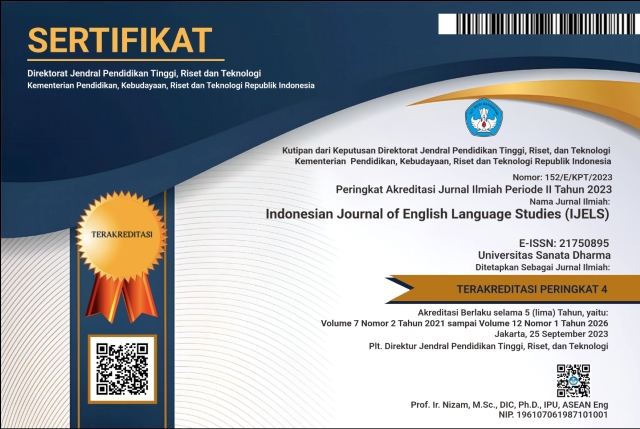The Collocations of the English Words Heart and Mind: Similarities and Differences
(1) Sanata Dharma University
(*) Corresponding Author
Abstract
Understanding collocations is essential to interpret meanings. This study aims to analyze the similarities and differences between the collocations of the English words heart and mind. About 99 data were taken from Corpus of Contemporary American English. The collocations were categorized based on the grammatical patterns. Then, the lexical meaning of each collocation was analyzed based on the context. The collocation patterns of the words heart and mind are almost similar. Seven categories of the collocations of the word heart include heart + noun (23.24%), heart + verb (20.20%), preposition + heart (16.16%), heart of + noun (15.15%), verb + heart (12.12%), other phrases (8.08%) and adjective + heart (5.05%). Meanwhile, seven categories of the collocation of the word mind include other phrases (33.33%), preposition + mind (30.30%), verb + mind (11.11%), noun + of mind (10.10%), adjective + mind (8.08%), mind + verb (6.06%) and mind + noun (1.01%). Collocations in the form of phrases tend to have idiomatic meanings. However, there is no clear relationship between the collocation patterns and meanings of both words.
Keywords
Full Text:
PDFReferences
Al-Smadi A. M. (2015). ‘Heart’ collocations as used in English and Arabic Languages. Journal of Literature, Languages and Linguistics, 11, 24-30.
Benson, M. (1986). Collocations and idioms. In R. F. Ilson (Ed.). EIT Documents 120: Dictionaries 120: Dictionaries. Lexicography and Language Learning. Oxford: Pergamon.
Bolinger, D. (1976). Meaning and memory. Forum Linguisticum I, 1- 14.
Cowie, A. P. (1981). The treatment of collocations and idioms in learner dictionaries. Applied Linguistics, 2, 223-235.
Cruse, D. A. (1986). Lexical Semantics. Cambridge: Cambridge University Press.
Fakhouri, S. (1995). Collocation in interpretation from English and Arabic [Thesis]. Yarmouk University- Jordan.
Klégr, A. (2007). Comparing collocations across languages: An English-Czech sample. Prague: Charles University.
McCarthy, M. and O’Dell, F. (2006). English collocations in use. Cambridge: Cambridge University Press.
Nofal, K. H. (2012). Collocations in English and Arabic: A comparative study. English Language and Literature Studies, 2 (3), 75-93.
Parlog, H. 2005. The Semantics of heart: Translation problems. English Language and Literature Studies in the Context of European Language Diversity, 2, 77-85.
Sinclair, J. (1991). Corpus, concordance, collocation. Oxford: Oxford University Press.
DOI: https://doi.org/10.24071/ijels.v2i2.553
Refbacks
- There are currently no refbacks.

This work is licensed under a Creative Commons Attribution-ShareAlike 4.0 International License.
IJELS Journal Sinta 4 Certificate (S4 = Level 4)
We would like to inform you that Indonesian Journal of English Language Studies (IJELS) has been nationally accredited Sinta 4 by the Ministry of Education, Culture, Research and Technology of the Republic of Indonesia based on the decree No. Surat Keputusan 152/E/KPT/2023. Validity for 5 years: Vol 7 No 2, 2021 till Vol 12 No 1, 2026

This work is licensed under CC BY-SA.
Creative Commons Attribution-ShareAlike 4.0 International License
IJELS e-ISSN 2715-0895; IJELS p-ISSN 2442-790X
Indonesian Journal of English Language Studies (IJELS) is published twice a year, namely in March and September, by the English Language Studies (ELS) of the Graduate Program of Sanata Dharma University, Yogyakarta, Indonesia.


 IJELS p-ISSN:
IJELS p-ISSN: 









